ACKNOWLEDGEMENTS :
I express my sincere thanks for reading the draft of the article below and for forwarding me their observations to :
– Michael Hawkeye Herman (http://www.hawkeyeherman.com/)
– Thijmen Vonk (http://www.jazz-pianist.nl/)My honest thanks go also to Dr. John T. Tennison for pointing me to the very detailed and scholarly research that he already made available on www.bowofo.org in preparation of his book on the history of boogie woogie.
Michael Hortig was also so kind as to send me the references of some thoroughly researched articles which he wrote after local research and interviews. Michael Hortig is an enthusiastic (boogie woogie) piano player, collector and researcher on piano blues since more than 35 years. He was so kind as to let me include the direct link to his articles which are readily available on my site by clicking the links below the article.
Of course, the responsibility for what is published hereunder is entirely mine and does not imply any position or opinion from their side.
________________________________________________________________
I still remember the footage when Joseph William Perkins (1913 – 2011), in 2011 at age 97, won the Grammy Award for the Best Traditional Blues Album: “Joined at the Hip,” an album that he had recorded with Willie “Big Eyes” Smith. He seemed perhaps a bit ‘frail’ in his old age, but was still full of music. Perkins, an open and friendly man (as Michael Hawkeye, who knew him, confided me), was the oldest-ever Grammy winner. A few weeks later he died from a heart attack in Texas. He had at that moment more than 20 performances booked for the rest of the year. Shortly before his death he conceded that he couldn’t play piano like he used to. “I used to have bass rolling like thunder. I can’t do that no more”, he said. He was one of the last original Mississippi Delta blues musicians, who also had known personally the legendary Robert Johnson.
Joseph William Perkins is better know as “Pinetop” Perkins. He got the name “Pinetop” in the 1950s when he recorded “Pinetop’s Boogie Woogie”, written by Clarence “Pinetop” Smith, at the studio of Sam Phillips in Memphis. But, who was Pinetop Smith? This question brings us back to the 29th of December 1928 when Clarence Smith (born 1904) recorded “Pine Top’s Boogie Woogie,” one of the first “boogie woogie” style recordings that became a hit, and which definitely introduced the name for this style of piano playing. A few months later he would be the unfortunate victim of a stray bullet launched during a fight between the bartender and a customer in a dance-hall in Chicago. However, his short musical career had lasted long enough to make him the reference for later stars not only in the boogie woogie style, but also for names like Ray Charles and many jazz musicians.
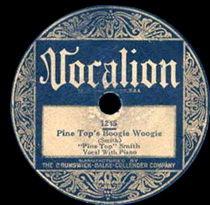 With his 1928-recording the style only acquired its name on the music scene (15). The style itself goes back much further on the history line. Let me take you along for a short journey back in time, a journey which only aims at giving you a rough brush of the history of this musical style by which “listeners have no choice but to submit to its mood-enhancing power”, and by which “even the most reserved audience will start tapping their feet by the time the first chorus has ended, and a real boogie fan will start cheering like a madman the moment he sees the pianist walk onstage” (Paterok). Let me point out from the start that much of what is described as the history of boogie woogie has no more than an anecdotal basis. The “when” and “where” questions have some answers, but these answers, plausible as they may seem, remain questionable. So, forgive me if I am sometimes seduced to making statements which seem definitive. Please always bear in mind that they are not to be taken for granted.
With his 1928-recording the style only acquired its name on the music scene (15). The style itself goes back much further on the history line. Let me take you along for a short journey back in time, a journey which only aims at giving you a rough brush of the history of this musical style by which “listeners have no choice but to submit to its mood-enhancing power”, and by which “even the most reserved audience will start tapping their feet by the time the first chorus has ended, and a real boogie fan will start cheering like a madman the moment he sees the pianist walk onstage” (Paterok). Let me point out from the start that much of what is described as the history of boogie woogie has no more than an anecdotal basis. The “when” and “where” questions have some answers, but these answers, plausible as they may seem, remain questionable. So, forgive me if I am sometimes seduced to making statements which seem definitive. Please always bear in mind that they are not to be taken for granted.
A terminological sidewalk can help us already quite a bit on the way.
There exists no agreement on the origin of the word “boogie-woogie”. The Oxford English Dictionary contends that the word is a reduplication of boogie, which was used for rent parties as early as 1913.
Dr. John Tennison, a Texas psychiatrist, pianist, and musicologist has made a link to four African terms, including the words “Boog” and “Booga,” both of which mean “to beat,” in the sense of beating a drum. There is also a West African word “Bogi,” which can be translated as “to dance,” and a Congo term “Mbuki Mvuki,” which means “shucking off one’s clothes so as to be able to better dance or perform.” Certainly, these meanings remind us of the percussiveness, the dancing, and the uninhibited behaviours which can be associated with Boogie Woogie, and a point can be made as to the African origin. However, we may not be tempted to conclude from this that boogie woogie is African. The Boogie Woogie music is born in America. The same author moreover points out that there is evidence that might suggest that the terminology “Boogie” might have a Gaelic origin.
In other theories the terminology is associated with the “bogeyman”, an imaginary being used by adults to frighten children into behaving, where in some cases the bogeyman is a nickname for the devil. The word would refer to some very ancient folk tales which exist all over the world (‘boeman’ in Dutch, ‘böggel-man’ in German, ‘el hombre del saco’ in Spanish,…).
The term “boogie-woogie” was also used in the nineteenth century by blacks in the American South to refer to secondary syphilis, a term thus with sexual connotations. It this meaning, its etymological roots would not be far off those of ‘jazz’, which could in its origin refer to copulation before it was applied to music and dancing (1).
Paul Oliver mentions the term “booger-rooger”, which describes an uninhibited party. In that respect it deserves attention to refer also to Blind Lemon Jefferson who popularized this particular variant of “Boogie Woogie”. (13) Max Haymes (14) quotes a reference to sexually flavoured dances in the Cherokee-culture.
One could even make the link with the English word “bogie” which is a wheeled wagon or trolley. In mechanics terms, a “bogie” is a chassis or framework carrying wheels, attached to a vehicle. From here, it is only a small leap to the train, which is historically often associated with this type of music as a source of inspiration.
These meanings are congruent with the style of the music. Peter Silvester has described it very well by the title of his referential book : “A left hand like God”. Boogie Woogie can be generically depicted as a heavily percussive style of piano playing in which the right hand plays riffs (syncopated, repeating phrases) against a driving pattern of repeating eighth notes (ostinato bass). (2) The player’s right hand plays an improvised part, independent of the steady rhythm maintained by the left. Put in another way : boogie woogie is a piano playing style marked by an up-tempo rhythm, a repeated melodic pattern in the bass, and a series of improvised variations in the treble. William Russell describes it as “rhythmically more simple than some types of African music, but more complex and poly rhythmic than the conventional jazz-piano style. The rapid, hypnotic patterns of the left hand are often set against ever changing rhythms of the right hand, causing the most exciting cross-rhythms.” (3)
The words by which the style was known before Pinetop Smith had it forever baptized as ‘Boogie Woogie’ tell us already a bit more of the whereabouts of its place of birth. Some of the earlier words used were : “sixteens”, “Fast Western”, “Fast Blues” and “Galveston”. Galveston and “Fast Western” bring us to Texas. “Sixteens” is the name that Eubie Blake (pianist of ragtime and jazz, 1887-1983) gave to the piano playing by William Turk, a ragtime pianist, who played a boogie woogie bass in the 1890’s (17). He was said to be so obese that he could not put his left hand in front of his stomach, which lead him to invent techniques playing with his left hand to the side. The rumour is that the boogie woogie playing came from this obese situation. ‘Sixteens’ was also known as “Dudlow Joe”, named after one of the early pioneers.
We are in Texas, second half of the 19th century, the Reconstruction period. The words let us also feel the buoyant energy. Boogie Woogie is in the first place dance music. As Robert Shaw (blues and boogie woogie pianist, 1908-1985) said :”when you listen to what I’m playing, you got to see in your mind all them gals out there swinging their butts and getting the mens excited. Otherwise you ain’t got the music rightly understood. I could sit there and throw my hands down and make them gals do anything. I told them when to shake it, and when to hold it back (‘squat low, mama, let your daddy see… you got something keeps on worrying me’) That’s what this music is for.” 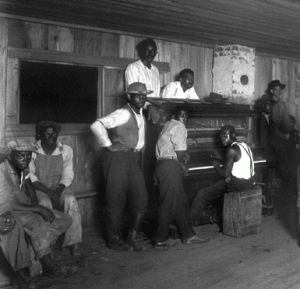
We enter more particularly the smoky Texan barrel houses with their pianos. The piano was a popular instrument (all over America) (4). Already in 1823 America saw the start up of a successful piano-manufacturing firm where the assembly-line techniques lead to reduced costs. The functional upright design of the piano also made it an instrument that could be easily stored and transported on trains. Though other instruments were certainly present in the barrel houses, the piano was an extremely popular entertainment instrument in those wooden shacks which were set up by the white employers as an informal establishment for the entertainment of their mainly African American labour force in the Texas pine top woods. It were primitive wooden constructions with a bar quickly set up with barrels. As Silvester describes it : a crude room with a piano, a dance area and access to rough liquor. And crude they were : it is said that it was not uncommon that during a weekend one or more workers got killed in a liquor drowned fight over gambling and women.
Though certainly some of the labourers themselves in the absence of a pianist played the instrument, the latter was mainly played by itinerant, self-taught musicians moving from one barrel house to another. They stayed for some time and were offered by the owner accommodation, food and drinking. They were nomads who, if they could stay neutral in the barrel house fights, could enjoy a relative freedom and control of their own lives and destiny, a luxury which was not reserved for their audience.
Their audience were African American workers in logging camps in the woods or in the small surrounding towns associated with timber and the draining of the pine top resin for the turpentine (*) industries, in levee camps for the repairing of the riverside embankments, and not to forget the railroad industry. Following the devastating effect of the Civil War, there was a huge need for rebuilding the destroyed railways, and the Reconstruction Period witnessed also a major expansion in the density of the railroad tracks.
According to some authors, the origin of boogie woogie lays in the Southeast of Texas, others locate it in the Northeast. Dr. John Tennison has collected convincing material that would locate the origin in the Northeast of Texas, with Marshall being the municipality which can be most strongly identified with the roots of this music style. Marshall calls itself by the way “The Birthplace of Boogie Woogie“(16).
Without taking stance in this discussion, for which I am not qualified, I would like to suffice here with painting by a rough brush the backdrop of the backwoods with its the barrel houses hidden in the pinewoods of Texas and in the small urban centers. Whether it was the smell of resin and turpentine or the battering sound of falling pines, whether it were the hazards of inhaling turpentine or the risk of being crashed by a tree or loosing a limb when sawing the wood, doesn’t really matter. The fact is that the living and working conditions were on the edge of being hellish. One author quotes a worker from a lumber camp who stated that if he had his choice between spending three months in a lumber camp and the same amount of time in jail, he would unhesitatingly choose the latter (5).
Against this background, the blues were sounding all over in the barrel houses for the dominantly African American working population who tried to drown their depletion and frustration and forget all about the hazards they faced during the day in a whirl of dance, music, liquor, card games and women. Several instruments were used for this entertainment, but the piano was – as said above – a favourite for the accompaniment of those early blues musicians. It allowed to play a fierce rhythm and harmony at the same time, and above all, it had the capacity to sound stronger than the boisterous audience. The strong interaction between the piano and the audience was by the way an essential element in the emergence of this energetic and creative musical style full of spontaneity.
The itinerant musicians improvised and learned from each other as they made their way along their different musical stages, ever perfecting their style and adding more and more sophistication to it.
The train has often been associated with the boogie woogie, and it is certainly one of the major themes. It is not hard to find in the boogie woogie sound scape a sonic resonance of the rhythm of the train, with its whistling, tracking the rail roads. Also symbolically, the train can be looked upon as iconic, in that it represented freedom, a way out, following tracks that lead out of misery, to the cities where freedom and money – so it was thought – were readily available. And, finally, practically, the train was a major means of transportation for the nomadic musician who either caught the freight train as a stowaway, or – when he was lucky – could make a friendly deal with the conductor.
Gradually, from only an accompaniment of the blues, boogie woogie evolved as an independent, instrumental style. As such, it also made its way – by the end of the 19th, beginning of the 20th century, to the larger cities throughout the southern counties. It kept however its initial character : it remained “primitive and unsophisticated music, music for the rough, uncultured, uneducated law-breaker and wrong-doer, and for the pimp, pander and prostitute.” (Silvester, p. 32). It was music that was heard in the city backstreets, in the brothels, and more particularly in the brothels at the outskirt of society.
The interaction between boogie woogie and guitar blues is complex, and worked probably in two ways. There are similarities between the bass playing on the piano and the bass playing in (some) guitar blues. It is not unlikely that the pianists were partially inspired by the guitar blues; it is also likely that the guitar blues inherited elements from the further evolution of the boogie woogie as the guitarists came into competition with pianists over getting a gig (and pay). The boogie woogie was popular, and the blues guitarist was playing for largely the same audience. It would be interesting to investigate how the bluesy, melancholic, component of the boogie woogie evolved over time, from its early beginnings through the second generation pianists from the twenties and further on. One could probably conclude that boogie woogie developed itself more and more as an independent musical style with its own idiom, detaching itself further and further from the original blues format.
In any case, boogie woogie found its roots, as did the blues, in an ever evolving musical space of folk art.
Entertainment was a main objective, and as such it established itself in this space, next to the ragtime, which enjoyed its peak popularity in the first two decades of the previous century. It began, with its ‘ragged’ march rhythm also as dance music in the red-light districts of American cities such as St. Louis and New Orleans. Although it was not uncommon that one musician would have both boogie woogie and ragtime on its repertoire the styles were different, and their historic evolution would also walk different paths. Ragtime had its heydays before the sound recording in the twenties were made popular, but it would in its turn influence some other styles amongst which Piedmont blues (6).
The creativity of individuals transcends the boundaries of any style and often defies too zealous an attempt to categorize music. Such is certainly true for a figure as James ‘Jimmy’ Blythe who in his short life time (1901-1931) left its musical footprints. He was a versatile pianist and productive composer that handled many styles; one of his works (Chicago Stomp)(18), however is considered as one of the earliest recorded examples of boogie woogie. Though their interest was perhaps not as big as for the then ruling female vocal blues, the record companies noticed the commercial potential of this dazzling piano style. Other musicians found their way to the recording studio, of whom Charles Edward Davenport, with his roots in vaudeville (8) and Clarence Williams (at the same time a brilliant entrepreneur who quickly observed the market value of the New Orleans music in the North) (9) (10). Charles Edward Davenport ’s “Cow Cow Blues”, in which he imitated a train with his piano and which also gave rise to his nickname (Cow Cow Davenport), would become one of the most frequently played boogie tunes of all time.
Seminal figures in the early days of the recorded boogie woogie were, not to forget, the Thomas brothers, George and Hersal, who demonstrated to the city musicians how to play real southern-style boogie woogie (11). They were of the first to bring the style out of Texas and into Chicago. The composition “The Fives” stands as a hallmark in the development of the boogie woogie, and later stars of the genre would often acknowledge that they had been influenced by this piece. It was instrumental in shaping the later ‘Boogie Woogie’ by musicans as Ammons and Meade.
Thus, by the time that ‘Boogie Woogie’ scored its first recording hit in 1929 with ‘Pinetop Smith’s’ recording, using its own, proper name, the musical genre had already a long way behind it from the pine top woods to the cities of New Orleans and the Northern cities and especially Chicago. With its driving, beating rhythm it had become the preferential music of the house parties and speakeasies that thrived on the prohibition law (until 1932). Just as in its early days in the barrel houses, it still provided the beat for liquor impregnated dancing. However, by now the pianists had achieved a certain social “status”. “Their services were highly in demand” , they were able to attend – for free – parties where food and drinks were abundant but which usually required the guests to pay an entrance fee (11).
The story was told that some of the best boogie woogie players were also the best eaters. Music and dinner, what a splendid combination.
With the Great Depression came also the hardship for the record business. Record sales dropped spectacularly and the pianists had a tough time finding gigs that allowed them enough bread and butter to live. Many a cabaret hall, nightclub and jazz cellar had to close its door, forcing the musicians to look for other means of livelihood.
It was only from the second half of the thirties that things started to look more brightly. Swing and big band music, as another genre that had emerged from African American roots, had started to triumph as a separate style from jazz since 1935. White teenagers and young adults were the main public, dancing also to the swing music that was brought by the radio and the recordings. On the blues stage, the cheap BlueBird Records stimulated the career of many an artist under the guidance of producer Lestor Melrose, who virtually monopolized the Chicago Blues market. Boogie Woogie would witness its ‘revival’ in great extent to the efforts of John Hammond (19), but it fitted well into the global social and economic environment that also sustained the popularity of the swing and the (standardized) beat tempo promoted by Melrose.
The well known ‘From Spirituals to Swing’ concerts organised by the Vanderbilt-heir Hammond in 1938 and 1939 in the Carnegie Hall and which were to showcase the evolution of African American music, were the kick off for the popularity of (also) the boogie woogie virtuosos Meade Lux Lewis, Pete Johnson and Albert Ammons. They became, through their perfection of piano playing, the most famous pianists of the time. As Paterok states : “The golden age of boogie had begun, and a veritable boogie woogie fever could be felt everywhere. In the years that followed, the three self-taught master pianists were finally able to establish themselves firmly, both financially and musically, and they regularly recorded in solo, duo and trio formations”. “To this day, their perfect interplay is still regarded as the reference point for all boogie woogie piano duos” (11). Undoubtedly, the start of the recording career of the (older) Jimmy Yancey in 1939, who already played boogie woogie in the 1910’s, was a consequence of the huge rise of popularity of Boogie Woogie in the wake of the Carnegie Hall concerts. At that moment his work around Chicago had already left its marks on MeadeLux Lewis, Pinetop Smith and Albert Ammons. (12)
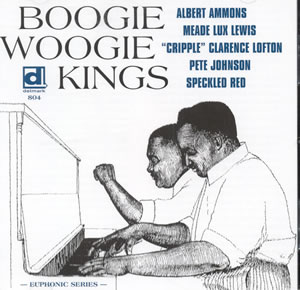 The craze also lead swing bands to incorporate the boogie woogie beat into some of their music. An updated version of Pine Top’s Boogie Woogie was issued by the popular, white bandleader and musician Thomas Dorsey and which would become a major swing era hit, not far from Glenn Miller’s “In the Mood”. The Andrews Sisters included some boogies, and gradually it was expected that every big band should have one or two boogie numbers in their repertoire.
The craze also lead swing bands to incorporate the boogie woogie beat into some of their music. An updated version of Pine Top’s Boogie Woogie was issued by the popular, white bandleader and musician Thomas Dorsey and which would become a major swing era hit, not far from Glenn Miller’s “In the Mood”. The Andrews Sisters included some boogies, and gradually it was expected that every big band should have one or two boogie numbers in their repertoire.
Boogie Woogie was now dressed with a bow tie. It had gained respectability, but at which price? The bow tie came together with an ever growing distance between the boogie woogie artist and his audience. The interaction between both was an essential element in the shaping of the creative, spontaneous and innovative musical energy that characterized the primitive boogie woogie. All this had disappeared by the end of the 1930’s and during the 40’s. It had became a victim of its own success. Certainly, its influence would fuel through later styles as rhythm & blues and even rock & roll, but only in a diluted form. We were far off from the early days when the rolling bass sound of the ‘fast western’ blared from the isolated barrel houses in the pine top woods of Texas.
____________________________________________
(1) http://www.answerbag.com/q_view/642436
(2) http://www.britannica.com/EBchecked/topic/73291/boogie-woogie
(3) in P. Silvester, A Left Hand Like God: A History of Boogie-Woogie Piano, 1989, page 5
(4) http://www.essortment.com/history-piano-21070.html
(5) http://www.uni.edu/iowahist/Social_Economic/LumberCamp/life_in_a_lumber_camp.htm
(6) B. Bastin, “Truckin’ My Blues Away: East Coast Piedmont Styles”, in Nothing But the Blues: The Music and the Musicians., 1993.
(7) http://www.boogiewoogie.info/HistTwo.htm
(8) http://www.redhotjazz.com/cowcow.html
(9) http://www.redhotjazz.com/williams.html
(10) See also for a summary overview, Thijmen Vonk – http://www.boogiewoogie.info/HistTwo.htm
(11) http://www.daniel-paterok.de/en/history-of-boogie
(12) http://www.redhotjazz.com/jimmyyancey.html
(13) http://nonjohn.com/History%20of%20Boogie%20Woogie.htm
(14) http://www.earlyblues.com/Essay%20-%20Booger%20Rooger%20Blues.htm
(15) Dr. John Tennison has collected evidence that Pinetop Smith was not the first to use the term ‘Boogie Woogie’ to refer to the style of music played in his “Pine Top’s Boogie Woogie”.
(16) http://www.facebook.com/birthplaceofboogiewoogie?ref=ts&sk=wall
(17) Edward Komara, ed., Encyclopedia of the Blues, 2006 (p.768)
(18) Dr. John Tennison points out that “() although Blythe’s “Chicago Stomp” is probably the first audio recording of a piece that used a ostinato Boogie Woogie bass figure throughout almost the whole piece, the 1919 recording of “Weary Blues” by the “Lousisiana Five” is the first audio recording” which is known to use a Boogie Woogie bass figure. He is – to my knowledge – the first author to identify this recording by the “Louisiana Five” as the earliest audio recording of a Boogie Woogie bass figure, this contrary to many sources which cite pieces recorded in the 1920s as being the first “Boogie Woogie” recordings. (email exchange between Dr. John Tennison and myself in July 2011)
(19) See also my post on http://www.myblues.eu/blog/?p=531
___________________________________________________________________________
Additional Reading put at the disposal by Michael Hortig :
1. Meade Lux Lewis : The life and Music of Meade Lux Lewis, celebrating his 100th birthday.
2. Speckled Red : The life and Music of Speckled Red.
3. Stop the Grinder Down : Texas Blues Piano (Parts 1 & 2)
___________________________________________________
(*) Turpentine is a fluid obtained by the distillation of resin obtained from trees, mainly pine trees. The primary uses of turpentine in industry are as a solvent and as a source of materials for organic synthesis.
The workers in (south) Texas were called ‘turpentiners’ : Chester Norris of Broaddus, who in 1973 shared his memories as a turpentine camp boss with a writer, said turpentiners “were the meanest people who ever lived.” “They’d kill each other…one or two every Saturday night. If they didn’t have gambling and a barrel house to get drunk in, they’d move on to camps where they did have ’em.”
Working in the turpentine sector was extremely hazardous.
(http://www.texasescapes.com/DEPARTMENTS/Guest_Columnists/East_Texas_all_things_historical/Turpentiners1BB701.htm)
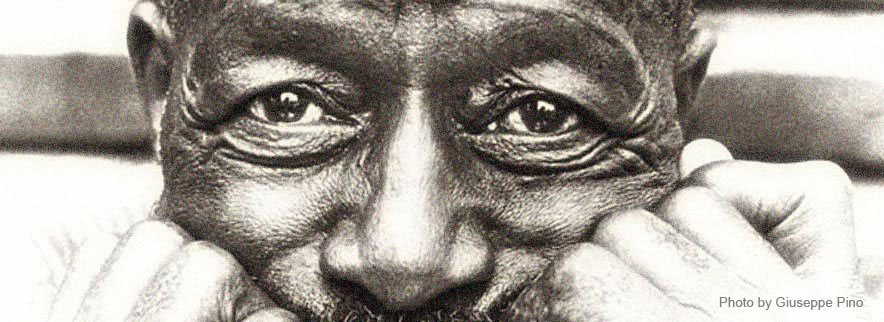
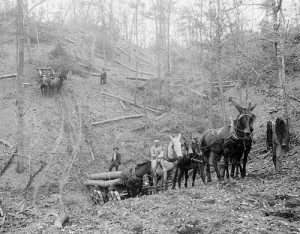
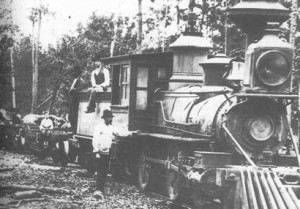
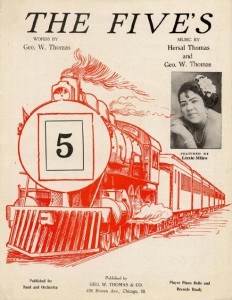


[…] Continue Article Here… http://www.myblues.eu/blog/?p=1198 […]